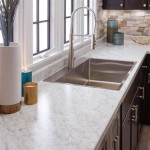Best Stain for Butcher Block Countertops
Butcher block countertops, crafted from solid wood, offer a rustic charm and enduring durability that many homeowners adore. However, the natural character of wood means that it can be susceptible to stains and discoloration over time. To enhance the beauty and longevity of your butcher block countertops, applying a stain is an essential step. Choosing the right stain can significantly impact the final look and feel of your countertops. This article explores the best types of stains for butcher block countertops, providing insights into their characteristics, application techniques, and maintenance considerations.
Understanding the Types of Stains
Stain for wood countertops is broadly categorized into two main types: oil-based and water-based. Each type possesses distinct properties that affect the final finish, application process, and long-term durability.
Oil-Based Stains
Oil-based stains, traditionally formulated with linseed oil, penetrate deeply into the wood's pores, providing rich, vibrant colors and emphasizing the natural grain patterns. They tend to create a more even finish, particularly on porous woods like oak. Oil-based stains are known for their durability and resistance to water and heat, making them ideal for high-traffic areas like kitchens. However, they have a longer drying time and emit strong fumes during application, requiring adequate ventilation.
Water-Based Stains
Water-based stains, formulated with water as the primary solvent, offer a faster drying time and lower odor compared to their oil-based counterparts. They are also easier to clean up with plain water. Water-based stains are less likely to raise the grain of the wood, making them suitable for smoother, less textured surfaces. However, they may not penetrate as deeply as oil-based stains, leading to less vibrant colors and potentially fading over time.
Factors to Consider When Choosing a Stain
Selecting the best stain for your butcher block countertops requires considering several factors that influence the final aesthetic and performance:
Wood Type
The type of wood used for your countertops directly impacts the way a stain will interact with the surface. Some woods, like oak, are naturally porous and readily absorb stain, resulting in deep, rich colors. Other woods, like maple, have a tighter grain structure, requiring a more penetrating stain to achieve even coloration. Understanding the specific characteristics of your wood will help you choose a stain that complements its natural attributes.
Desired Color
Each stain offers a range of colors, from light and natural to dark and dramatic. Consider the overall design aesthetic of your kitchen and choose a stain that complements the existing color scheme. If you prefer a natural, subtle look, opt for a light stain that enhances the wood's natural grain. For a more dramatic effect, consider a dark stain that creates a rich, warm tone.
Finish Preference
The desired finish, whether matte, satin, or gloss, dictates the level of shine and reflection. Matte finishes provide a subtle, understated aesthetic, while satin finishes offer a soft sheen. Gloss finishes offer the highest level of shine and can accentuate the wood's natural beauty, but they can also highlight imperfections.
Popular Stain Brands for Butcher Block Countertops
Several reputable brands specialize in wood stains specifically formulated for butcher block countertops. These brands offer a diverse range of colors, finishes, and levels of durability, allowing you to find the perfect option for your project:
General Finishes
General Finishes is a well-known brand renowned for its high-quality wood stains and finishes. Their water-based stains are known for their ease of application, quick drying time, and low odor. They offer a wide range of colors, including natural, amber, and walnut, for a variety of aesthetic preferences.
Minwax
Minwax is another reputable brand that offers a comprehensive line of wood stains. Their oil-based stains are known for their deep penetration and rich, vibrant colors. Minwax also offers water-based stains for those seeking faster drying times and lower odor. Their extensive color palette caters to diverse design styles.
Varathane
Varathane offers a diverse range of wood finishes, including stains, sealers, and varnishes. Their stains are known for their durability and resistance to water and heat, making them suitable for high-traffic areas. Varathane offers both oil-based and water-based stains, allowing you to choose the type that best suits your project needs.
Application Techniques for Stain
Proper application is crucial to achieving a consistent and attractive stain finish. Here are some key steps to follow for applying stain to your butcher block countertops:
Preparation
Before applying the stain, ensure that the countertop is clean and free of debris. Sand the surface with fine-grit sandpaper to create a smooth and even surface. This will allow the stain to penetrate evenly and create a more consistent finish.
Application
Apply the stain evenly with a brush or cloth, working in the direction of the wood grain. Allow the stain to penetrate the wood for the amount of time recommended by the manufacturer. Use a clean cloth to wipe away excess stain and ensure that the surface is evenly coated.
Drying and Curing
Allow the stain to dry completely before applying a sealant. The drying time varies depending on the type of stain and environmental conditions. Once the stain is dry, apply a sealant to protect the countertops from water, stains, and scratches.
Maintenance Considerations
Proper maintenance is essential to preserving the beauty and durability of your stained butcher block countertops. Here are some tips for keeping your countertops looking their best:
Regular Cleaning
Clean your countertops regularly with a mild soap and water solution. Avoid using harsh cleaners, as these can damage the stain and sealant.
Resealing
Reseal your countertops periodically to maintain their protective barrier. The frequency of resealing depends on the level of use and the type of sealant applied. Consult the manufacturer's instructions for specific recommendations.
Avoiding Scratches
Use cutting boards when preparing food to avoid scratches on the countertop surface. Also, avoid using abrasive cleaning tools that can damage the stain and sealant.

How To Choose Stain For Butcher Block Truemans Treasures

Staining My Butcher Block Counters A Life Unfolding

How To Stain Butcher Block The Home

How To Stain Butcher Block Countertops Painting By The Penny

How To Stain Butcher Block The Home

How To Choose Stain For Butcher Block Truemans Treasures

How To Stain Butcher Block The Home

How To Finish Butcher Block Countertops Forever Joint Tops

How To Stain Butcher Block Countertops Painting By The Penny

Staining My Butcher Block Counters A Life Unfolding
See Also








